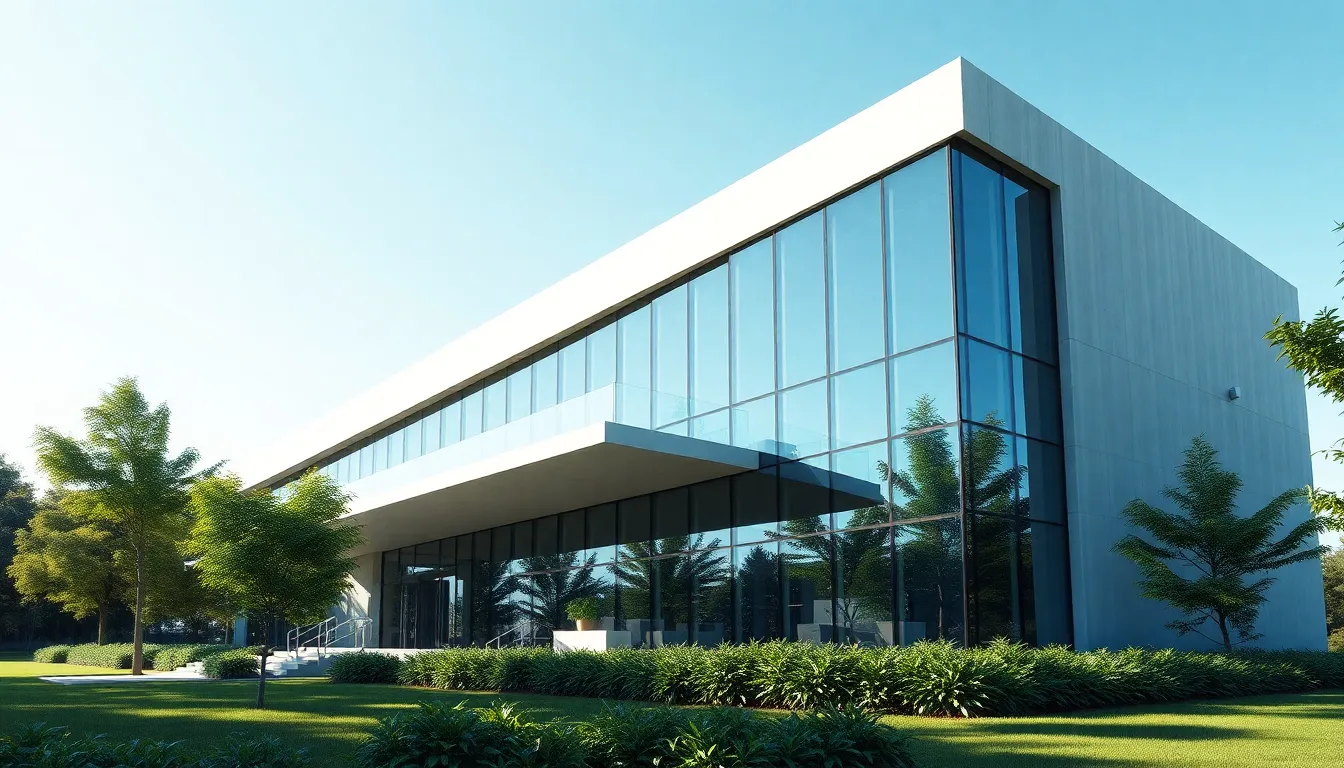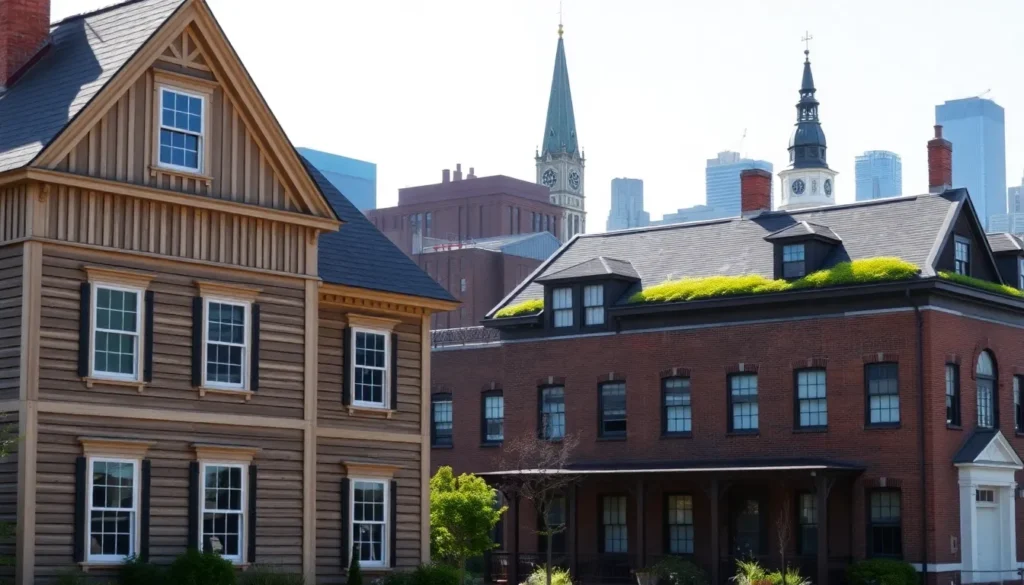Table of Contents
ToggleModern architecture isn’t just about sleek lines and glass facades; it’s a bold statement about how we live, work, and play. Imagine walking into a space that feels like a breath of fresh air, where creativity meets functionality in a dance of design. From minimalist homes that whisper elegance to skyscrapers that challenge gravity, modern architecture captures the imagination and reshapes our cities.
Overview of Modern Architecture
Modern architecture reflects a shift in design philosophy, focusing on new materials and technology. It embraces simplicity, functionality, and a connection to the surrounding environment. Minimalist styles often dominate residential buildings, while urban architecture features innovative designs like skyscrapers.
Influential architects have shaped modern architecture significantly. Le Corbusier introduced concepts such as open floor plans and large windows, which allow natural light to enhance interior spaces. Frank Lloyd Wright advocated for designs that harmonize with nature, exemplified by the famous Fallingwater residence.
Sustainable practices play a major role in contemporary architectural designs. Green roofs, solar panels, and responsible materials prioritize environmental impact. These features create buildings that not only serve their purpose but also contribute positively to the ecosystem.
Cultural influences also define modern architecture. Globalization leads to diverse styles merging seamlessly. Influences from various regions create distinctive structures that reflect local cultures while meeting contemporary needs.
Innovation continues to push boundaries in urban planning. Smart city concepts integrate technology with infrastructure, enhancing the quality of life for residents. Technologies such as 3D printing and modular construction streamline building processes, offering new possibilities for architects.
Modern architecture serves as a visual representation of societal values. Spaces that prioritize connectivity, inclusivity, and sustainability mark this era. Ultimately, these architectural advancements address practical challenges while inspiring creativity in design.
Key Features of Modern Architecture

Modern architecture showcases distinct characteristics that enhance both aesthetics and utility. It prioritizes elements like simplicity, innovation, and sustainability.
Minimalism and Functionality
Minimalism defines modern architecture, emphasizing clean lines and open spaces. Functional designs often promote usability and accessibility without unnecessary clutter. Open floor plans foster fluid movement between rooms. Natural light becomes a core component, enhancing the ambiance in living spaces. Additionally, this approach encourages a connection between indoor and outdoor environments. By reducing excess, the focus shifts to essential design elements that create harmony. Architects concentrate on practicality while ensuring the visual appeal remains intact. Spaces are crafted to serve multiple purposes, making them more adaptable.
Use of New Materials
Innovative materials play a crucial role in modern architecture. Glass, steel, and concrete dominate structures, providing durability and aesthetic value. High-performance glass improves energy efficiency by maximizing natural light and minimizing heat loss. Steel frames allow for taller buildings and unique shapes, transforming skylines. Concrete offers versatility, enabling sculptural designs to emerge. Additionally, eco-friendly materials are gaining traction, supporting sustainable goals. Properties like recycled content and low environmental impact enhance modern designs. Architects continuously explore these advancements, pushing creative boundaries and redefining spaces. Taking advantage of these materials can result in remarkable architectural feats that inspire and engage communities.
Influential Modern Architects
Modern architecture owes much of its evolution to key figures like Frank Lloyd Wright and Le Corbusier. These architects have left indelible marks on the field through their innovative designs and philosophies.
Frank Lloyd Wright
Frank Lloyd Wright championed organic architecture, emphasizing harmony between structures and their environments. He introduced the concept of open floor plans, which prioritized fluid living spaces and increased natural light. His iconic designs, such as the Fallingwater house, showcase integration with nature. Wright’s use of local materials and innovative building techniques significantly advanced the architectural landscape. Notably, his Prairie Style emphasizes horizontal lines that align with the Midwestern landscape, reflecting the philosophy of blending form with function.
Le Corbusier
Le Corbusier revolutionized urban planning and architecture with his visionary ideas. His concept of the “Modulor” system combined human proportions with architectural design, enhancing usability in living spaces. Noteworthy projects, such as Villa Savoye, exemplify his emphasis on pilotis, open floor plans, and horizontal windows. Le Corbusier advocated for cities organized around functionality, promoting a balance between aesthetics and practicality. His designs often incorporate modern materials like concrete and glass, underscoring the potential of industrial techniques in creating meaningful architecture.
Impact on Urban Development
Modern architecture significantly influences urban development by transforming cities into vibrant, functional landscapes. It encourages the integration of residential, commercial, and recreational spaces. Architects design mixed-use buildings that foster community interactions, attracting diverse populations to urban centers.
Urban infill projects emphasize sustainability while addressing land scarcity. These initiatives reuse and repurpose vacant lots or underutilized structures, promoting increased density without expanding city boundaries. Smart city concepts incorporate technology into urban planning, enhancing efficiency and improving residents’ quality of life.
Green spaces play a critical role in modern urban designs. Incorporating parks and gardens in urban areas fosters biodiversity and offers residents outdoor recreational opportunities. Eco-friendly materials and energy-efficient designs minimize environmental impacts, aligning with contemporary sustainability goals.
Open floor plans facilitate fluid movement between spaces, encouraging social connections. Arranging buildings around public squares or promenades enhances walkability, promoting healthier lifestyles. Designs prioritize natural light and ventilation, resulting in comfortable living and working environments.
Cultural narratives shape modern architectural expressions. Local inspirations lead to distinctive structures that resonate with communities, reflecting their heritage. The blending of various architectural styles enhances urban identity, creating unique, recognizable cityscapes.
While influential architects set trends, collaboration between urban planners and architects drives successful projects. This multidisciplinary approach results in designs that balance aesthetics with functionality, meeting practical needs. Ultimately, modern architecture serves as a catalyst for urban evolution, reshaping environments to reflect contemporary values and lifestyles.
The Future of Modern Architecture
Emerging trends in modern architecture indicate a strong focus on sustainability and technology. Innovations such as advanced materials, like self-healing concrete and recycled composites, dominate discussions. Architects are increasingly prioritizing eco-friendly designs that integrate seamlessly with their surroundings.
Cities worldwide are adopting smart technologies, enhancing efficiency in urban infrastructure. These improvements include intelligent building systems that manage energy consumption dynamically. Urban planners work alongside architects to create multifunctional spaces that encourage community engagement and reduce environmental footprints.
Furthermore, biophilic design principles gain traction as they emphasize connections between people and nature. Structures featuring green walls and natural ventilation not only benefit aesthetics but also improve occupants’ well-being.
The use of parametric design software allows architects to explore complex forms that were previously unattainable. This technology fosters creativity while adapting to site-specific conditions effectively. In addition, modular construction methods streamline building processes, reducing time and costs without compromising quality.
Collaborative efforts among global architects lead to diverse styles that express unique cultural narratives. This synthesis creates distinctive landmarks that resonate with local communities and reflect current lifestyle trends.
As urbanization accelerates, mixed-use developments become vital in promoting sustainability and vibrant living environments. Integrating parks, retail spaces, and residences in one area enhances community interaction and accessibility.
Lastly, the incorporation of renewable energy solutions, such as solar panels and wind turbines, underscores architecture’s role in combating climate change. Investment in research and development ensures that modern architecture continues to evolve, meeting future challenges effectively.
Modern architecture stands as a testament to innovation and creativity in design. It’s not just about aesthetics; it reflects the evolving needs of society and the environment. By embracing sustainability and advanced technologies, architects are crafting spaces that enhance urban life and foster community connections.
The integration of natural elements and eco-friendly practices is reshaping how cities function. As urbanization continues to accelerate, the focus on mixed-use developments and smart technologies will play a crucial role in creating vibrant living environments.
Ultimately, modern architecture is more than a style; it’s a movement that inspires change and challenges traditional boundaries, paving the way for a more sustainable and interconnected future.


